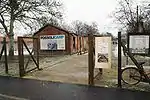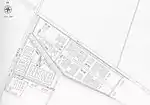Fossoli camp
The Fossoli camp (Italian: Campo di Fossoli) was an internment camp in Italy, established during World War II and located in the village Fossoli, Carpi, Emilia-Romagna. It began as a prisoner of war camp in 1942, later being a Jewish concentration camp, then a police and transit camp, a labour collection centre for Germany and, finally, a refugee camp, before closing in 1970.
| Fossoli camp | |
|---|---|
| Concentration camp | |
 Panorama of the camp | |
 Location of Fossoli camp within Italy | |
| Coordinates | 44°49′42″N 10°54′10″E |
| Location | Carpi, Italy |
| Commandant | Domenico AvitabileMario TaglialatelaKarl Friedrich Titho |
| Operational | 1942 |
| Notable inmates | Primo Levi |
| Notable books | The Periodic Table |
It is estimated that 2,844 Jews passed through this camp, 2,802 of whom were then deported.
History
Prisoner of War camp
The camp was established by the Royal Italian Army on 30 May 1942 for the British, South African and New Zealand military personnel captured in military operations in North Africa and originally called Campo PG 73. On 22 July 1942 1,800 prisoners of war were moved to the camp and accommodated in 191 tents in what was called the "Old camp", the Campo Vecchio. With the surrender of Italy on 8 September 1943 the camp was evacuated and all prisoners of war moved to Germany.[1][2]
Concentration camp
After the surrender, the camp was enlarged by 60 wooden and 20 stone barracks which became the "New camp", the Campo Nuovo. In December the camp was renamed Fossoli di Carpi and became the "national concentration camp" for the Jews in the Italian Social Republic, following the issue of RSI Police Order No. 5. The camp was operated by fascist Italian militias.[1] Police captain Domenico Avitabile was the first Italian commandant of the concentration camp, succeeded by Mario Taglialatela. Avitabile was described by former inmates as a kind but corrupt man while Taglialatela was described as cruel and as mistreating the prisoners.[3][4][5]
In March 1944, owing to the camp's strategic location close to the Modena–Verona railway line, the Campo Nuovo came under German control and was renamed Transit camp Carpi. It now fell under jurisdiction of the German Commander in Chief of the Security Police, Wilhelm Harster, who was based in Verona, while the Campo Vecchio remained under Italian control. SS-Untersturmführer Karl Friedrich Titho was appointed as commander of the German part of the camp, with SS-Hauptscharführer Hans Haage as his deputy, while the guards consisted of 40 Italians, later reinforced with five Ukrainians.[1]
The purpose of the camp was to act as a transit camp and it was to be filled to capacity with Italian Jews and, once full, these were to be deported predominately to Auschwitz for extermination. It was during this period that the first two trains left for Auschwitz on 19 and 22 February 1944, with the camp still under Italian control. The second convoy left with 650 other prisoners (which Primo Levi recalls in the first pages of the famous book If This is a Man).[1]
During Titho's time as camp commander at Fossoli di Carpi, 67 prisoners were executed in the Cibeno massacre as a reprisal for a partisan attack on German soldiers at Genoa. On 12 July 1944 70 prisoners were selected on the pretext of being taken to Germany and their names read out by Titho, moved on trucks to a local shooting range and 67 of them executed while three managed to escape.[6] For his role in the execution of the prisoners, the Italian media latter referred to him as the Executioner of Fossoli.[7]
During its existence as a transit camp, the camp had a total of 5,000 inmates, of which around half were Jewish. The last transport for Auschwitz left the camp on 26 June 1944,[1] Fossoli having become too insecure because of the proximity to the front line, and was replaced with the Bolzano Transit Camp, with Titho and Haage as the commander and deputy commander as well. Following the final deportation of Jews, the camp was used for the deportation of forced labour to Germany with as many as 800 to 1,000 people transiting through the camp daily. In November 1944 the camp ceased operations.[2]
After the Second World War
From November 1945 to May 1947 the camp was once more in use, now for foreign refugees,[1] some of them Jewish Holocaust survivors.[2]
In 1947 the camp was converted into a refuge for war orphans, by Father Zeno Saltini. The Church ordered Saltini to leave in February 1952, and the community was closed with huge debts. There was a satellite community in Maremma which today comprises the intentional community of Nomadelfia.[8]
The camp reopened once more from 1954 to 1970 to serve as accommodation for ethnic Italian refugees from Yugoslavia before it finally closed.[1][2]
Commemoration
In 1996 a foundation was formed to preserve the former camp. From 1998 to 2003 volunteers rebuilt the fencing around the Campo Nuovo and, in 2004, one of the barracks that used to house Jewish inmates was reconstructed.[1]
Notable inmates
- Roberto Angeli
- Nedo Fiano
- Mario Finzi
- Odoardo Focherini
- Primo Levi
- Liana Millu
- Teresio Olivelli
- Raimondo Ricci
- Francesco Venturelli
- Ricardo diLuca
- Armando Vezzelli
- Jerzi Sas Kulczycki
- Carlo Bianchi
- Leopoldo Gasparotto
Gallery
 Camp today
Camp today Barracks
Barracks Allied POW camp
Allied POW camp Camp's plan
Camp's plan
See also
References
- Der Ort des Terrors: Geschichte der nationalsozialistischen Konzentrationslager Bd. 9: Arbeitserziehungslager, Durchgangslager, Ghettos, Polizeihaftlager, Sonderlager, Zigeunerlager,Zwangsarbeitslager (in German). Wolfgang Benz, Barbara Distel. 2009. ISBN 9783406572388. Retrieved 9 September 2018.
- "FOSSOLI". ANED – National Association of Italian political deportees from Nazi concentration camps. Retrieved 10 September 2018.
- Megargee, Geoffrey P.; White, Joseph R. (2018-05-29). The United States Holocaust Memorial Museum Encyclopedia of Camps and Ghettos. ISBN 9780253023865. Retrieved 21 September 2018.
- Sullam, Simon Levis (2018-08-28). The Italian Executioners: The Genocide of the Jews of Italy. ISBN 9780691184104. Retrieved 21 September 2018.
- Thomson, Ian (2003). Primo Levi. ISBN 9780099515210. Retrieved 21 September 2018.
- "Poligono del Cibeno, Fossoli, Carpi, 12.07.1944" (in Italian). Atlas of Nazi and Fascist Massacres in Italy. Retrieved 10 September 2018.
- Schwarzer, Marianne (17 February 2016). "Dem "Henker von Fossoli" blieb ein Prozess auf deutschem Boden erspart" [The „Executioner of Fossoli“ is spared from a trial on German soil]. Lippische Landes-Zeitung (in German). Retrieved 9 September 2018.
- Utopian Dreams, Tobias Jones, 2007, Faber and Faber Ltd, pp 58-59.
Bibliography
- Sacchi, Danilo (2002). Fossoli: transito per Auschwitz : quella casa davanti al campo di concentramento. Firenze: Giuntina. ISBN 978-88-8057-138-4.
- Lallo, Angelo.; Toresini, Lorenzo. (2001). Psichiatria e nazismo : la deportazione ebraica dagli ospedali psichiatrici di Venezia nell'ottobre 194. Portogruaro (Venezia): Nuova dimensione. ISBN 978-88-85318-60-1.
- Castelli, Enrico (2005). Musei territori percorsi. Morlacchi Editore. p. 408.
- Sanfilippo, Matteo (2006). "Per una storia dei profughi stranieri e dei campi di accoglienza e di reclusione nell'Italia del secondo dopoguerra". Centro Studi Emigrazione. 164: 535–566. hdl:2067/751.
- Steinacher, Gerald (2006). "L'Alto Adige come regione di transito dei rifugiati (1945-1950)". Centro Studi Emigrazione. 43 (164).
- This article was initially translated from the Italian Wikipedia.
External links
- The Police Transit Camps in Fossoli and Bolzano
- (in Italian) The Fossoli Foundation
 Media related to Fossoli concentration camp at Wikimedia Commons
Media related to Fossoli concentration camp at Wikimedia Commons